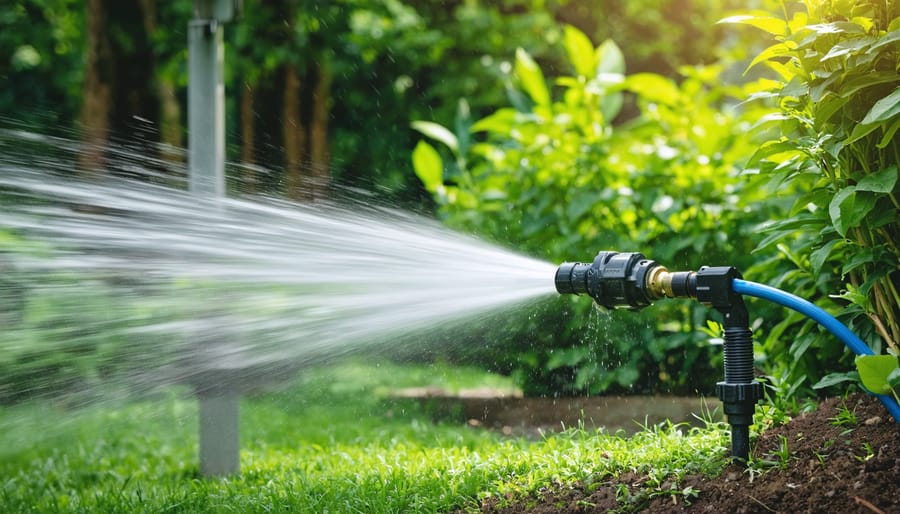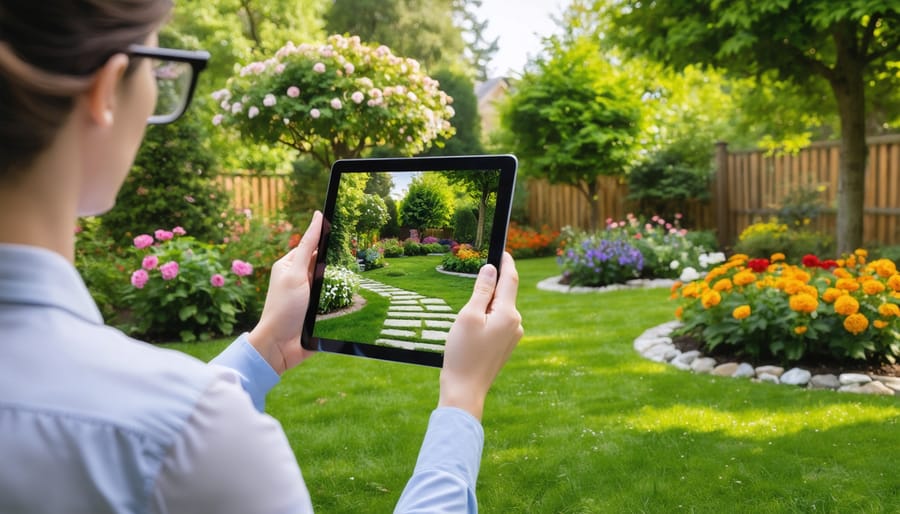Harness the sun’s endless energy to power your garden’s irrigation system with solar-powered garden hose pumps – an innovative solution that combines sustainable technology with practical gardening needs. These ingenious devices capture solar energy through photovoltaic panels, converting sunlight into electricity that drives a compact water pump, eliminating the need for traditional power sources or manual watering efforts.
Unlike conventional electric pumps, solar-powered garden hose pumps work by creating a self-sustaining system that operates during daylight hours, precisely when your plants need water most. The solar panels feed energy to a controller, which manages the pump’s operation based on available sunlight, while some models include battery storage for cloudy days or evening operation.
Whether you’re maintaining a small herb garden or managing extensive landscaping, these eco-friendly pumps offer reliable, cost-effective irrigation while reducing your carbon footprint. Understanding their operation helps gardeners make informed decisions about implementing sustainable watering solutions that align with nature’s rhythms.
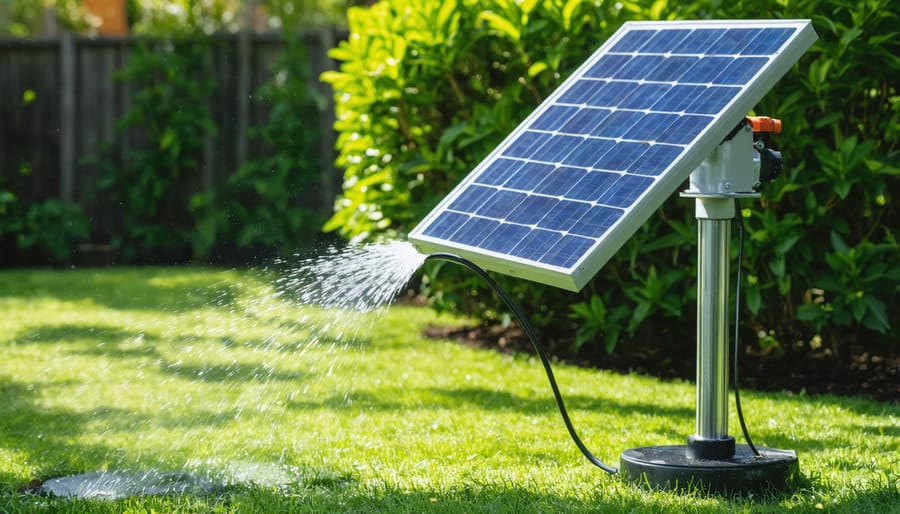
How Solar-Powered Garden Hose Pumps Work
Solar Panel Components
The heart of any solar-powered garden hose pump is its solar panel array, which converts sunlight into usable electricity. These panels are made up of photovoltaic cells, typically constructed from silicon, that work their magic when sunlight hits their surface. Think of them as tiny energy collectors, each doing their part to power your garden’s water system!
Most garden pump systems use panels ranging from 5 to 20 watts, depending on your water flow needs. The panels are covered with tempered glass for protection and usually come with an aluminum frame that makes them weather-resistant and durable enough to withstand outdoor conditions.
What I love about modern solar panels for garden pumps is their improved efficiency – even on cloudy days, they can still generate enough power to keep your water flowing, though at a reduced rate. The panels connect to the pump through a simple wire system, often including a small controller that helps manage the power flow.
Many panels come with adjustable stands, letting you angle them to catch maximum sunlight throughout the day. For best results, position your panels facing south (in the Northern Hemisphere) at roughly a 45-degree angle – this setup typically captures the most sunlight for consistent pump operation.
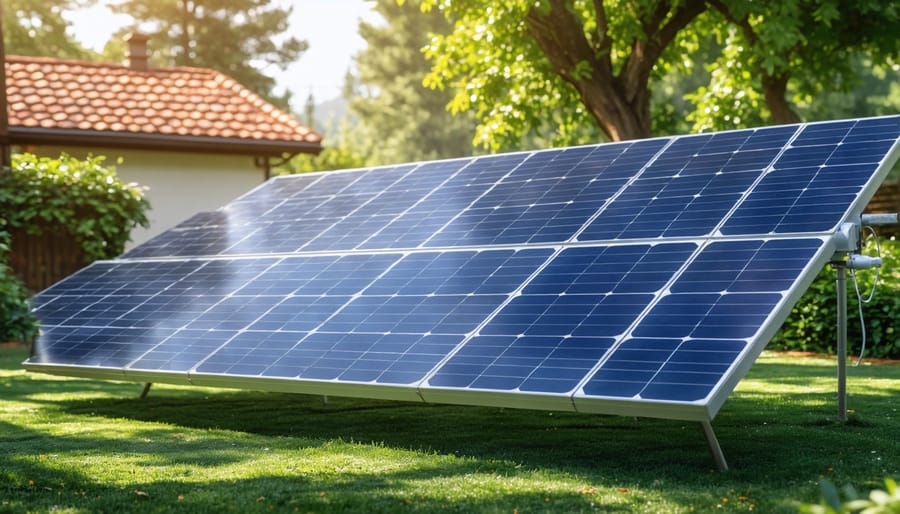
Pump Mechanism
The heart of a solar-powered garden hose pump lies in its clever conversion system. When sunlight hits the solar panel, it creates electrical energy that powers a small but efficient motor. This motor is connected to either a centrifugal or diaphragm pump mechanism, depending on the model. Think of it like a tiny waterwheel inside your pump – as the motor spins, it creates the force needed to move water through the system.
In centrifugal pumps, rotating impellers create centrifugal force that pushes water outward and upward. Imagine swinging a bucket of water in a circle – that’s similar to how these pumps work! Diaphragm pumps, on the other hand, use a flexible membrane that moves up and down, creating suction that draws water in and then pushes it out through your garden hose.
Most solar pumps include a DC motor that’s specifically designed to work with the variable power output from solar panels. This means your pump can keep working even when clouds partially block the sun, though it might run a bit slower. Some models even come with battery backup systems, ensuring your garden stays watered even during less sunny periods.
Installation and Setup
Choosing the Right Location
Selecting the perfect spot for your solar-powered garden hose pump is crucial for optimal performance. The solar panel needs direct sunlight for maximum efficiency, so choose a location that receives at least 6-8 hours of sunlight daily. South-facing positions typically work best in the Northern Hemisphere, as they capture the most sunlight throughout the day.
Keep your solar panel clear of shadows from trees, buildings, or other structures that might reduce its effectiveness. If possible, mount the panel on an adjustable bracket so you can modify its angle seasonally – a steeper angle in winter and a flatter position in summer maximizes sun exposure.
As for the pump itself, position it as close to your water source as possible to reduce strain on the system. Ensure it’s protected from extreme weather conditions and flooding. Many gardeners find success placing the pump in a small, weatherproof housing or under a simple shelter while keeping it easily accessible for maintenance.
Remember to consider your garden layout when planning the installation. The pump should be positioned where it can efficiently distribute water to all your intended areas while keeping hose lengths manageable.
Connection and Testing
Now that you have all your components ready, let’s connect them and make sure everything works properly. Start by placing your solar panel in a sunny location, ideally facing south for maximum sun exposure. Connect the panel to the pump controller using the provided cables, making sure all connections are secure and waterproof.
Next, attach your garden hose to both the inlet and outlet ports of the pump. The inlet hose should reach your water source (like a rain barrel or pond), while the outlet connects to your smart garden irrigation solutions or regular watering system.
Before running the system, prime the pump by filling it with water to remove any air pockets. Once primed, turn on the controller and watch for water flow. You should see steady water movement within a few moments. If you notice any leaks or irregular flow, double-check all connections and seals.
Test the system throughout the day to ensure it performs well under different sunlight conditions. Remember that pumping power will vary with available sunlight, so it’s best to conduct initial tests on a clear, sunny day.
Maintenance and Troubleshooting
Keeping your solar-powered garden hose pump in top condition doesn’t have to be complicated. Regular maintenance is key to ensuring your system runs smoothly throughout the gardening season. Here’s what you need to know to keep things flowing.
Start with a monthly cleaning routine for your solar panels. Use a soft cloth and mild soap solution to remove dust, pollen, and bird droppings that can reduce efficiency. Remember to clean during early morning or evening to avoid handling hot panels.
Check your pump’s intake filter every two weeks during heavy use. Remove any debris, leaves, or sediment that might have accumulated. A clogged filter is often the culprit behind reduced water flow, but it’s an easy fix!
If you notice decreased performance, first ensure your solar panels are properly aligned with the sun. Sometimes, seasonal changes require slight adjustments to maintain optimal exposure. Also, inspect all hose connections for leaks or loose fittings – a common source of pressure loss.
For winter preparation, drain all water from the system and store the pump indoors if you live in an area that experiences freezing temperatures. This simple step prevents damage and extends your pump’s lifespan.
Common issues like air locks can be resolved by briefly lifting the pump above water level while running. If the pump isn’t starting on sunny days, check the wiring connections for corrosion or damage, and ensure the panels are clean and unobstructed.
Remember to keep spare washers and O-rings on hand for quick repairs. With these simple maintenance steps and troubleshooting tips, your solar pump system should provide reliable service for many growing seasons to come.
Smart Integration Options
Modern solar-powered garden hose pumps can be seamlessly integrated into your existing garden technology ecosystem, making your outdoor space smarter and more efficient. By connecting your pump to smart irrigation systems, you can automate your watering schedule based on weather conditions, soil moisture levels, and plant needs.
Many current models come with Bluetooth or Wi-Fi connectivity, allowing you to control your pump through smartphone apps. You can monitor water flow rates, check battery levels, and adjust pump settings from anywhere. Some systems even integrate with virtual assistants like Alexa or Google Home, enabling voice control of your garden irrigation.
The real magic happens when you pair your solar pump with moisture sensors throughout your garden. These sensors communicate with your pump system to deliver water only when needed, preventing both overwatering and water waste. Many gardeners I’ve spoken with particularly love the automated scheduling features, which ensure their plants get the right amount of water at optimal times.
For those new to smart gardening, most manufacturers provide user-friendly setup guides and companion apps that make the integration process straightforward. You don’t need to be tech-savvy to benefit from these features – they’re designed to make gardening easier, not more complicated.
Remember to choose a pump system that offers the connectivity options you’ll actually use. Sometimes, simpler solutions work best for your specific garden needs.
Environmental and Cost Benefits
Switching to solar-powered garden hose pumps offers remarkable environmental and financial benefits that make them an attractive choice for eco-conscious gardeners. Unlike traditional electric pumps, these sustainable devices harness free solar energy, reducing your carbon footprint and eliminating the need for grid electricity in your self-sustaining garden systems.
The initial investment in a solar pump typically pays for itself within 2-3 years through energy savings alone. Many gardeners report saving $150-$300 annually on their electricity bills after making the switch. Plus, with minimal moving parts and no fuel costs, maintenance expenses are significantly lower than traditional pumps.
These pumps’ environmental impact is equally impressive. A typical solar-powered pump can prevent approximately 500 pounds of CO2 emissions annually compared to electric alternatives. They’re also whisper-quiet, creating a more peaceful garden environment and avoiding noise pollution that can disturb wildlife and neighbors.
Water conservation is another key benefit, as many solar pumps come with smart controllers that optimize water usage based on sunlight availability. This means you’re not just saving energy – you’re also using water more efficiently, which is particularly valuable in regions with water restrictions or during dry seasons.
The best part? These systems keep working even during power outages, ensuring your garden stays properly watered no matter what. It’s a win-win for both your wallet and the planet.
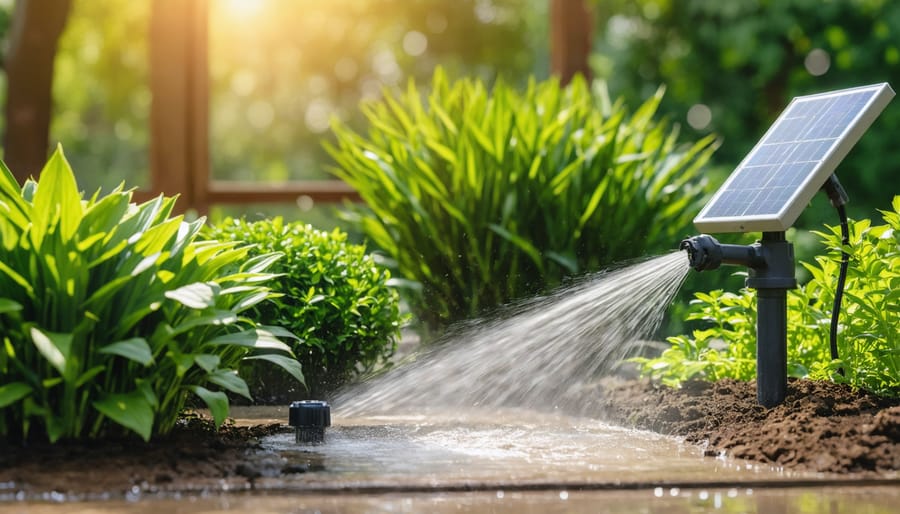
Solar-powered garden hose pumps represent an eco-friendly and efficient solution for your gardening needs. By harnessing the sun’s energy, these innovative systems can help you maintain a thriving garden while reducing your environmental impact and utility costs. We’ve explored how these pumps convert sunlight into usable power, their essential components, and the numerous benefits they offer to gardening enthusiasts.
Remember that proper installation and maintenance are key to getting the most out of your solar pump system. Whether you’re watering a small herb garden or managing a larger landscape, these sustainable solutions can adapt to your specific needs. With minimal upfront investment and virtually no operating costs, solar-powered garden hose pumps are becoming increasingly popular among conscious gardeners.
Take the first step toward sustainable gardening by considering a solar-powered pump for your outdoor space. Your plants—and the planet—will thank you for it!

